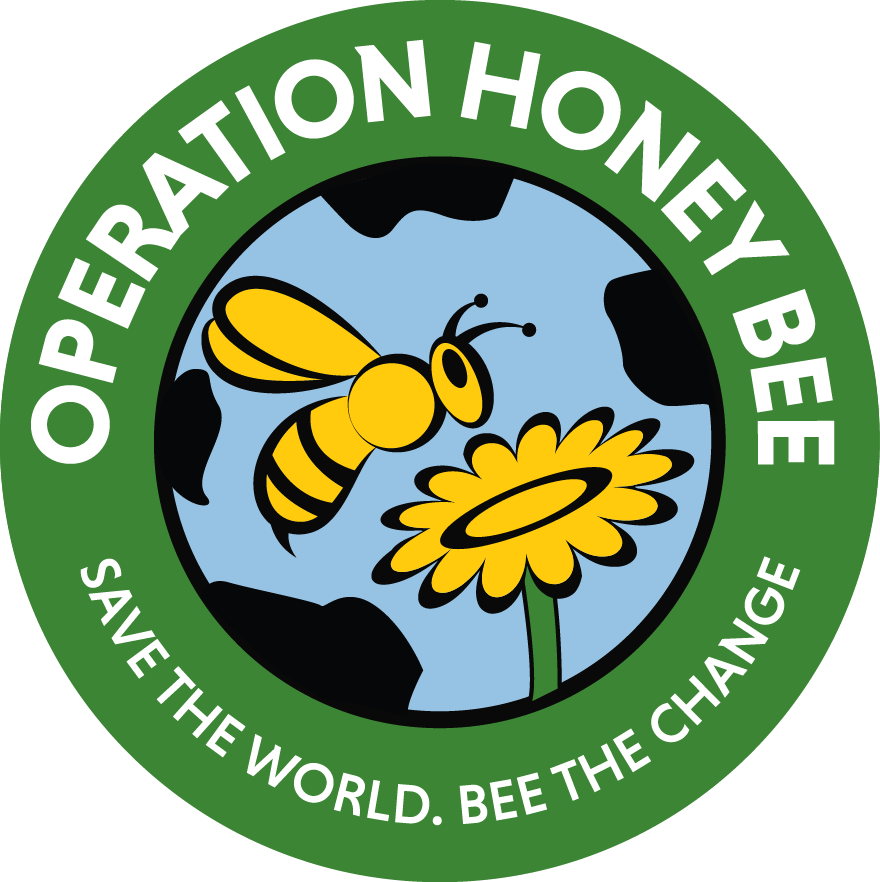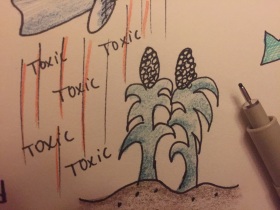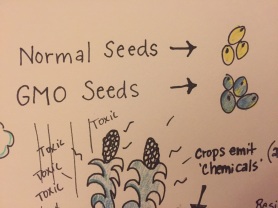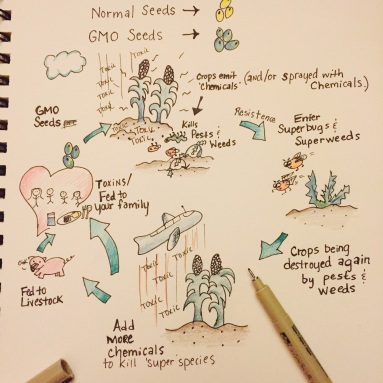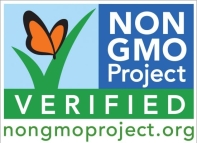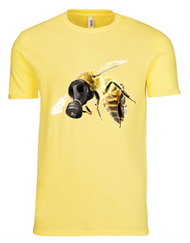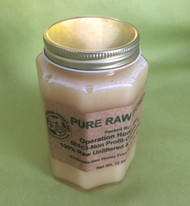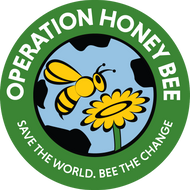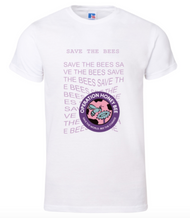- Home
- Change
- Learn About the Issues
- What is a GMO (Genetically Modified Organism)?
What is a GMO (Genetically Modified Organism)?
What is a GMO?
What is a GMO?
A GMO is defined as ‘genetically modified organism: an organism or microorganism whose genetic material has been altered by means of genetic engineering.’ [1]
Where is the harm in producing foods that are bigger and ‘better’ versions that could feed more people at a cheaper price? That was the original intent for introducing genetically engineered or modified products into our agricultural practices and thus into our marketplace.
Which foods contains GMO’s?
This article is about seeds and what seeds produce: crops for human and animal consumption and products. Listed here are statistics from a Huffington Post article Top 7 Genetically Modified Crops. [2]
- 93% of soybeans are genetically modified.
- 88% of American corn is genetically modified.
- 54% of sugar beets (where our sugar comes from) is genetically modified
- 90 % of the US Canola crop
The majority of processed foods contains one or more of the above mentioned ingredients. Up to 80% of our processed foods contain GMO’s.
Modifications, mutations, and cross breeding occur naturally in the wild. It’s hybridization. This can also be modified in a lab to produce, say, a bigger and better tomato. This seems innocent enough.
What genetic traits are the seeds being modified with, for what reasons, and why are we continuing to put heavily chemically treated crops in food? Our livestock is then feed these crop products and we consume this in the form of meat, eggs, or dairy. As well as produce.
When did we start consuming GMO’s?
GMO or GE (genetic engineering) technology has been developed since the early 1980’s but the food really hit our shelves in the 1990’s. ‘This technique, called “transgenic technology,” has been practiced only in recent decades’….[4] We didn’t have the kind of long-term human health data necessary to deem this newer technology as ‘safe’ and now we are knee deep in health epidemics in our country and it particularly affects our children.
“1997 – Mandatory Labels
The European Union rules in favor of mandatory labeling on all GMO food products, including animal feed.1999 – GMO Food Crops Dominate
Over 100 million acres worldwide are planted with genetically engineered seeds. The marketplace begins embracing GMO technology at an alarming rate.2003 – GMO-Resistant Pests
In 2003, a Bt-toxin-resistant caterpillar-cum-moth, Helicoverpa zea, is found feasting on GMO Bt cotton crops in the southern United States. In less than a decade, the bugs have adapted to the genetically engineered toxin produced by the modified plants.2011 – Bt Toxin in Humans
Research in eastern Quebec finds Bt toxins in the blood of pregnant women and shows evidence that the toxin is passed to fetuses.” [5]
The best timeline I could find is linked here from gmoinside.org and it’s where the dates above are quoted from. It’s easy to understand the history of GMO/GE technology being introduced into our agricultural practices from this site. Take notes of date of GMO introduction: they directly correlate to some statistics on disease in our country I discuss later in this article.
How does a GMO work?
“Genetically-modified food crop seeds fall into two general categories: herbicide resisters and pesticide creators.” [4]
Category 1: The crops are also considered ready to be sprayed with herbicides and pesticides. Hence, the genetic alterations protect the plant from being affected by the chemicals sprayed on them, it makes them ‘ready’ to be sprayed with chemicals. The crop seed and subsequent plant withstands this because of the genetic engineering.
Category 2: DNA of the seed is genetically infused (altered) to include insecticides. This is done so the plant, as it grows, will emit toxins that avert insects. A Bt gene is incorporated into the plant.
Use of herbicides has increased since GMO technology emerged. Why?
It was originally projected we would use less chemicals but this has not been the outcome.
Within those first 10 years of GMO’s being routinely used, ‘superweeds’ adapted that were resistant to the chemicals sprayed on the crops. How do you remedy this? You spray more glyphosate on them or a new chemical needs to be used in conjunction with the glyphosate. This means-more chemicals? I thought this patented technology was so we could use less chemicals.
Within those 10 years GMO resistant ‘superbugs’ developed that were resistant to pesticides. According to the Non GMO Project: GMO facts page:
‘GMO crops are also responsible for the emergence of “super weeds” and “super bugs:’ which can only be killed with ever more toxic poisons like 2,4-D (a major ingredient in Agent Orange).’
Nature obviously quickly adapts to its adversaries. ‘Superweeds first appeared in 2000 in a Delaware soybean field; they have since spread to more than 20 states.’ [4]
Image Source: justlabelit.org

Not only do we consume the products made from these crops, but these chemicals are destroying our ecosystem and contaminating our organic farmlands. We are fighting an uphill battle trying to combat nature rather than work with it.
I do not have the answers. What I do have is a voice: to ask for labeling of my food and to support organic farming practices by purchasing those products. We have a right to know.
Why do we allow this in the US food chain and other developed countries do not?
“Most developed nations do not consider GMOs to be safe. In more than 60 countries around the world, including Australia, Japan, and all of the countries in the European Union, there are significant restrictions or outright bans on the production and sale of GMOs.”[3]
‘In Europe all products containing more than .9 percent GMO are labeled as such.’ [9]
In fact, many countries ban the importation of GMO’s. Many are concerned that GMO’s have shown up in their local ecosystems, essentially contaminating their land.
In America we unknowingly consume food with chemicals in and on them every day. So we are we doomed? No- we do have choices.
How do we Feed the World if we don’t use GMO technology?
Numerous studies indicate that GMO technology is not better than traditional farming practices. Although the majority GMO crops are used towards feeding animals we still consume those animal products. Our homes and schools are still located near crop fields filled with chemicals. We are rapidly seeing environmental impacts and increases in human and animal diseases.
“GE crops – primarily corn and soybeans – have not substantially contributed to global food security and are primarily used to feed animals and cars, not people.
-
Studies show that GE crops in the US are not more productive than non-GE crops in western Europe.
-
A recent case study in Africa found that crops that were crossbred for drought tolerance using traditional techniques improved yields 30 percent more than GE varieties.” [8]
Social Media and an Effort to Engage the Public
I am not a farmer, I respect farmers. I truly respect organic farmers.
I posed this question on my social media yesterday: ‘Do you know what a GMO is? Hint: It’s in our food.’ I was overwhelmed at the intelligent and poised responses of those that replied with their current knowledge, their candor to how it affects their choices, how GMOs may already have affected their families, as well as honest admittance of those whom simply did not know.
I was at the same time saddened that more did not participate. However, it can be a lofty subject to tackle. It’s terrifying to think of making changes in your lifestyle. There are affordable ways to eat organically and your savvy of the subject will grow over time.
Why is there an Extreme Rise in Childhood Cancers, ADHD, Autism, and Food Allergies in the United States?
I am not a doctor, I am not a research scientist, and I am not a statistician. However, numbers speak volumes. The data is out there from objective and independent sources. You just have to look.
Americans are now producing and consuming more GMO’s than any other nation. Recall, the EU passed mandatory labeling laws for GMO’s back in 1997. America is still waiting…
‘Labeling will deliver multiple benefits. It is essential for tracking emergence of novel food allergies and assessing effects of chemical herbicides applied to GM crops. It would respect the wishes of a growing number of consumers who insist they have a right to know what foods they are buying and how they were produced.’ [6]
The statistics below are from the 2012 publication ‘A Generation in Jeopardy: How Pesticides are Undermining our Children’s Health and Intelligence’ published by Pesticide Action Network North America:
- Some 15 percent of all U.S. children have one or more developmental disabilities—representing a 17 percent increase in the past decade.
- The number of children diagnosed with ADHD increased an average of three percent every year from 1997 to 2006, and an average 5.5 percent per year from 2003 to 2007
- Autism rates jump 250% in one decade
- In California, the number of children with autism who are enrolled in statewide programs rose from 3,864 in 1987 to 11,995 in 1998, an increase of more than 210 percent in 11 years. ....Though shifts in diagnosis account for some of this dramatic rise, public health experts have determined that diagnostic changes do not fully explain the trend…
- Over the past 30 years, the number of children diagnosed with all forms of invasive cancer has increased 29 percent…..A large number of recent studies link pesticide exposure to childhood leukemia, brain tumors and neuroblastoma.
- The number of U.S. children with asthma today is much higher than it was 30 years ago, rising from 2.1 million in 1980 to 7.1 million in 2009.
- According to one recent national review, of the 40 pesticides most commonly used in schools, 28 are probable or possible carcinogens, 26 have been shown to cause reproductive effects, 26 damage the nervous system, and 13 have been linked to birth defects.
- Changes in the timing of sexual development over the past two decades have been so widespread that the age of “normal” puberty onset has been redefined by health professionals.
- In 2002, Baillie-Hamilton reviewed data suggesting that the obesity epidemic coincided with the marked increase in usage of industrial chemicals, including pesticides, over the past 40 years ….In the 10 years since this review, many studies have linked exposure to endocrine-disrupting chemicals with increased incidence of obesity and diabetes. [7]
Childhood Food Allergies are also on the Rise
My first born is a number in the statistics below My child has a life threatening peanut allergy and we are not sure why. His body responds to peanut proteins as a foreign invader and his histamine response goes into overdrive. He has no familial genetic factors that would increase his risk of a food allergy. I am interested particularly in this subject. I have to wonder, why does he have this? Leading studies suggest environmental factors are the cause…

US rates are higher than other countries…
‘Surveys were completed by parents of kids and teens in 2007 and 2008. Just over 20 percent of children born outside the U.S. had any type of allergic disease – including asthma, eczema, hay fever or food allergies – compared to between 34 and 35 percent of those born in the U.S. What’s more, the risk of allergies increased with the more time foreign-born children spent in the U.S., Silverberg and his colleagues wrote in JAMA Pediatrics.’ [10]
The number of young people who had a food or digestive allergy increased 18 percent between 1997 and 2007, according to a report by the Centers for Disease Control and Prevention. [11]
Now review the spike from 1997 to 2013:
A study released in 2013 by the Centers for Disease Control and Prevention stated that food allergies in children increased approximately 50% between 1997 and 2011. A 50% increase.
There is a correlation to note. When you look at the data these numbers for childhood diseases have all risen in the past 10-15 years and more rapidly in the US. What else has changed in the past 10-15 years? GMO’s in our food and more chemicals in our farmlands.
Obviously, other factors could be at play: the chemicals in our cosmetics, the chemicals in our cookware, antibiotic over-use, better diagnoses of ADHD and autism spectrum disorders to name a few. There are other theories to the food allergy rise in our country. The ‘clean theory,’ delayed exposure to food proteins, and gut bacterium environment.
In conclusion: There may be a direct link between childhood illnesses and GMOs. When deciding to purchase food and products for your family, please do your research. You may need to consider lifestyle changes to protect their health. It’s nearly impossible to avoid GMO’s altogether, but you can eliminate a vast majority if you buy organic. Look for USDA or Certified Organic or the NONGMOProject labels. I’ll post soon on what to look for on your labels. Also, if this article speaks to you, please take action!
Note: I did not want to breach intense political discourse in this article. So rather, you have some homework: Research which companies control the seed industry, what other industries the seed companies have ties to, and who is sponsoring studies that claim GMO’s are safe to consume.
Sources:
- Dictionary.com. “Define GMO.” Accessed September 24, 2015. http://dictionary.reference.com/browse/gmo.
- Kelly, Margie. “Top 7 Genetically Modified Crops.” October 20, 2012. http://www.huffingtonpost.com. Top 7 Genetically Modified Crops
- Nongmoproject.org. “GMO Facts. Frequently asked Questions.” Accessed September 23, 2014. www.nongmoproject.org
- 4. Odonnel, Kim. “The Abc’s of GMO’s.” October 1, 2013. http://www.crosscut.com http://crosscut.com/2013/10/primer-on-GMOs-I522-odonnel/
5. Shireen. “GMO timeline: A history of Genetically Modified Foods.” September 13, 2012. www.gmoinside.org- http://gmoinside.org/gmo-timeline-a-history-genetically-modified-foods/
6. Foley, Libby. “Citing GMO- Herbicide Link, Renowned Children’s Health Expert Calls for GMO Labeling.” August 20, 2015. www.ewg.org
7. Kristin S. Schafer, MA Emily C. Marquez, PhD “A Generation In Jeopardy.” Pesticide Action Network North America. October 2012. http://www.panna.org/sites/default/files/KidsHealthReportOct2012.pdf
8. Cassidy, Emily- EWG Research Analyst. “Feeding the World. Without GMO’s. March 31, 2015 http://www.ewg.org http://www.ewg.org/research/feeding-world-without-gmos
9. Novak, Sara. “Why is American one of the only Industrialized Nations with no GMO Labeling?” Howstuffworks.com. Accessed September 25, 2015. http://recipes.howstuffworks.com/why-is-america-one-of-the-only-industrialized-nations-with-no-gmo-labeling.htm
10. Reuters. “US Born Kids have more Allergies.” Published April 30, 2013. Foxnews.com http://www.foxnews.com/health/2013/04/30/us-born-kids-have-more-allergies-asthma/
11. CDC Publication noted in article: “Children’s Allergy Rate on the Rise.” April 20, 2011 Food consumer.org
Featured Products
-
$35.00

-
$25.00

-
$50.00

-
$25.00

-
$40.00

-
$17.00

-
$49.95

-
$25.00

-
$100.00

-
$5.00

-
$29.95

-
$29.95

-
$100.00

-
$29.95

 Loading... Please wait...
Loading... Please wait...
